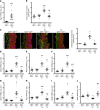SGK1 induces vascular smooth muscle cell calcification through NF-κB signaling
- PMID: 29889103
- PMCID: PMC6025998
- DOI: 10.1172/JCI96477
SGK1 induces vascular smooth muscle cell calcification through NF-κB signaling
Abstract
Medial vascular calcification, associated with enhanced mortality in chronic kidney disease (CKD), is fostered by osteo-/chondrogenic transdifferentiation of vascular smooth muscle cells (VSMCs). Here, we describe that serum- and glucocorticoid-inducible kinase 1 (SGK1) was upregulated in VSMCs under calcifying conditions. In primary human aortic VSMCs, overexpression of constitutively active SGK1S422D, but not inactive SGK1K127N, upregulated osteo-/chondrogenic marker expression and activity, effects pointing to increased osteo-/chondrogenic transdifferentiation. SGK1S422D induced nuclear translocation and increased transcriptional activity of NF-κB. Silencing or pharmacological inhibition of IKK abrogated the osteoinductive effects of SGK1S422D. Genetic deficiency, silencing, and pharmacological inhibition of SGK1 dissipated phosphate-induced calcification and osteo-/chondrogenic transdifferentiation of VSMCs. Aortic calcification, stiffness, and osteo-/chondrogenic transdifferentiation in mice following cholecalciferol overload were strongly reduced by genetic knockout or pharmacological inhibition of Sgk1 by EMD638683. Similarly, Sgk1 deficiency blunted vascular calcification in apolipoprotein E-deficient mice after subtotal nephrectomy. Treatment of human aortic smooth muscle cells with serum from uremic patients induced osteo-/chondrogenic transdifferentiation, effects ameliorated by EMD638683. These observations identified SGK1 as a key regulator of vascular calcification. SGK1 promoted vascular calcification, at least partly, via NF-κB activation. Inhibition of SGK1 may, thus, reduce the burden of vascular calcification in CKD.
Keywords: Cardiovascular disease; Cell Biology; Chronic kidney disease; NF-kappaB; Vascular Biology.
Conflict of interest statement
Figures










Similar articles
-
Augmentation of phosphate-induced osteo-/chondrogenic transformation of vascular smooth muscle cells by homoarginine.Cardiovasc Res. 2016 Jun 1;110(3):408-18. doi: 10.1093/cvr/cvw062. Epub 2016 Mar 21. Cardiovasc Res. 2016. PMID: 27001421
-
Role of SGK1 in the Osteogenic Transdifferentiation and Calcification of Vascular Smooth Muscle Cells Promoted by Hyperglycemic Conditions.Int J Mol Sci. 2020 Sep 29;21(19):7207. doi: 10.3390/ijms21197207. Int J Mol Sci. 2020. PMID: 33003561 Free PMC article.
-
SGK1-dependent stimulation of vascular smooth muscle cell osteo-/chondrogenic transdifferentiation by interleukin-18.Pflugers Arch. 2019 Jun;471(6):889-899. doi: 10.1007/s00424-019-02256-5. Epub 2019 Jan 31. Pflugers Arch. 2019. PMID: 30706178 Free PMC article.
-
Signaling pathways involved in vascular smooth muscle cell calcification during hyperphosphatemia.Cell Mol Life Sci. 2019 Jun;76(11):2077-2091. doi: 10.1007/s00018-019-03054-z. Epub 2019 Mar 18. Cell Mol Life Sci. 2019. PMID: 30887097 Free PMC article. Review.
-
MicroRNAs are critical in regulating smooth muscle cell mineralization and apoptosis during vascular calcification.J Cell Mol Med. 2020 Dec;24(23):13564-13572. doi: 10.1111/jcmm.16005. Epub 2020 Oct 22. J Cell Mol Med. 2020. PMID: 33089928 Free PMC article. Review.
Cited by
-
Role of inflammation and immunity in vascular calcification: a bibliometric and visual analysis, 2000-2022.Front Cardiovasc Med. 2023 Oct 30;10:1258230. doi: 10.3389/fcvm.2023.1258230. eCollection 2023. Front Cardiovasc Med. 2023. PMID: 37965089 Free PMC article.
-
Transcriptomic analysis of the cerebral hippocampal tissue in spontaneously hypertensive rats exposed to acute hypobaric hypoxia: associations with inflammation and energy metabolism.Sci Rep. 2023 Mar 6;13(1):3681. doi: 10.1038/s41598-023-30682-0. Sci Rep. 2023. PMID: 36878975 Free PMC article.
-
SGK1-Mediated Vascular Smooth Muscle Cell Phenotypic Transformation Promotes Thoracic Aortic Dissection Progression.Arterioscler Thromb Vasc Biol. 2025 Feb;45(2):238-259. doi: 10.1161/ATVBAHA.124.321421. Epub 2024 Dec 5. Arterioscler Thromb Vasc Biol. 2025. PMID: 39633576 Free PMC article.
-
Coronary artery calcification in patients with advanced chronic kidney disease.BMC Cardiovasc Disord. 2022 Oct 29;22(1):453. doi: 10.1186/s12872-022-02879-0. BMC Cardiovasc Disord. 2022. PMID: 36309659 Free PMC article.
-
Both high glucose and phosphate overload promote senescence-associated calcification of vascular muscle cells.Int Urol Nephrol. 2022 Oct;54(10):2719-2731. doi: 10.1007/s11255-022-03195-4. Epub 2022 Apr 8. Int Urol Nephrol. 2022. PMID: 35396645
References
Publication types
MeSH terms
Substances
LinkOut - more resources
Full Text Sources
Other Literature Sources
Molecular Biology Databases

